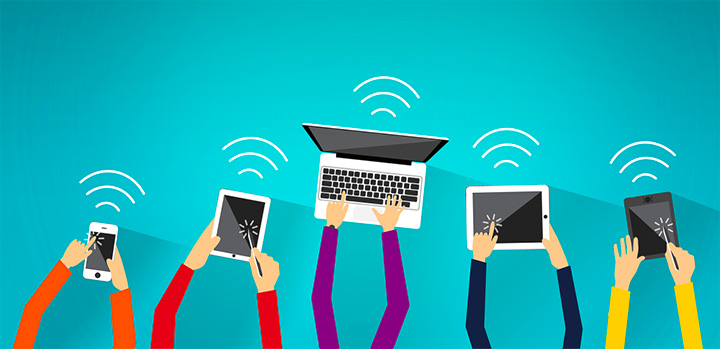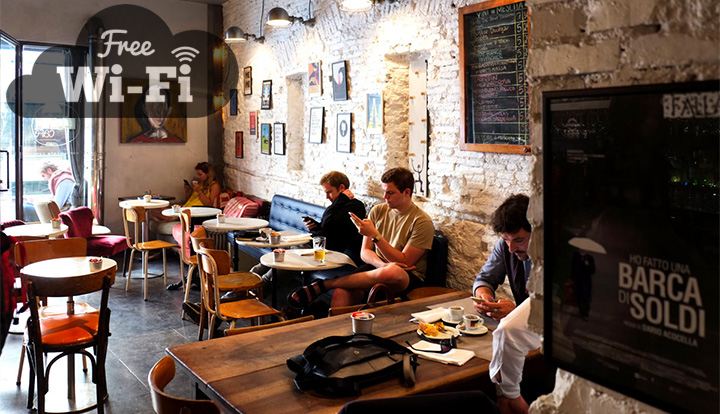
Free or Public Wi-Fi’s are a convenient way to stay connected to the web when you are on the go or not at home. But these types of connections are open and can pose risks to your device’s security. Here are some tips to keep safe when connecting to these types of Wi-Fi.
Table of Contents
When you are staying at a library or café the easiest way to stay safe when connecting to their Wi-Fi is to ask the staff for the name or SSID of the network you would connect to.
Another way to keep safe when connecting to public Wi-Fi’s is to turn off your file sharing and mark the Wi-Fi network as public. For Windows Users you can find these settings in the Control Panel > Network and Sharing Center > Change Advanced Sharing Settings.

For Mac users, open up your System Preferences and look for the Sharing icon then uncheck File Sharing. Additionally, you should also disable your guest account and remove unneeded share points to prevent others from accessing your Mac device. For disabling guest accounts and removing unneeded share points follow the steps below.
Removing Unneeded Share Points — go to the Sharing system preferences and select the File Sharing section. Here you will see the Public folders for each account. To remove these folders simply select them and click on the minus button.
VPNs (Virtual Private Networks), aside from faking which country you’re in, provide additional security and privacy to your connection by encrypting and tunneling the data you send and receive and by replacing your IP address. VPNs can be used by PCs and Mobiles alike. Be wary though and only use trusted VPN providers as this could backfire and instead of protecting your device you might endanger it.
Always check which websites you are visiting. Certain browsers, like Google Chrome, would send out warnings whenever you are entering a site with an unsecured connection or unreliable security certification. This would most probably be denoted by a red crossed out padlock on the address bar while secured websites would be denoted by a green padlock.
If your device or app has extra security features like two-factor authentication or secondary pins then it would be wise for you to use them. In an event that you would be compromised due to connecting to a public Wi-Fi then at least you have another layer of security.

Once you disconnect from any Public or Free Wi-Fi’s it is advised that you forget it, this would prevent your devices from auto connecting to these networks and any similarly named ones in the future. Below are the steps on how to forget a network connection.
• For Windows users – uncheck the “Connect automatically” box on the network’s name before connecting to it. Alternatively, you could go through the Control Panel > Network and Sharing Center click on the networks name then on “Wireless Properties” then uncheck the “Connect automatically when this network is in range.” Box.
• For Mac Users – Head to System Preferences look for Network then under the Wi-Fi section click on Advanced. Under the advanced section uncheck “Remember networks this computer has joined.” You can also remove any other registered networks by selecting them and pressing the minus button.
• For Mobile Users – Long press on the network’s name and select “Forget Network”
Being aware and cautious of these potential pitfalls can save you a lot of headaches. Just do the routine checks on a regular basis and just be mindful every time you ask for the WiFi password. We’re working with Globe on a series of #makeITsafePH articles and guides to help you be more informed and attentive when logging online.
More #makeITsafePH security tips:
- 5 ways to spot a Phishing Site from a Mile Away
- 10 Email Tips to Keep Away from Spam
- How to Manage Internet Use for your Children
- How to Clean your PC from Malware
- 6 Internet Security Tips in The Workplace
- How to Keep Safe when using Public or Free WiFi
- 4 Signs Your Online Accounts May Have Been Compromised

YugaTech.com is the largest and longest-running technology site in the Philippines. Originally established in October 2002, the site was transformed into a full-fledged technology platform in 2005.
How to transfer, withdraw money from PayPal to GCash
Prices of Starlink satellite in the Philippines
Install Google GBox to Huawei smartphones
Pag-IBIG MP2 online application
How to check PhilHealth contributions online
How to find your SIM card serial number
Globe, PLDT, Converge, Sky: Unli fiber internet plans compared
10 biggest games in the Google Play Store
LTO periodic medical exam for 10-year licenses
Netflix codes to unlock hidden TV shows, movies
Apple, Asus, Cherry Mobile, Huawei, LG, Nokia, Oppo, Samsung, Sony, Vivo, Xiaomi, Lenovo, Infinix Mobile, Pocophone, Honor, iPhone, OnePlus, Tecno, Realme, HTC, Gionee, Kata, IQ00, Redmi, Razer, CloudFone, Motorola, Panasonic, TCL, Wiko
Best Android smartphones between PHP 20,000 - 25,000
Smartphones under PHP 10,000 in the Philippines
Smartphones under PHP 12K Philippines
Best smartphones for kids under PHP 7,000
Smartphones under PHP 15,000 in the Philippines
Best Android smartphones between PHP 15,000 - 20,000
Smartphones under PHP 20,000 in the Philippines
Most affordable 5G phones in the Philippines under PHP 20K
5G smartphones in the Philippines under PHP 16K
Smartphone pricelist Philippines 2024
Smartphone pricelist Philippines 2023
Smartphone pricelist Philippines 2022
Smartphone pricelist Philippines 2021
Smartphone pricelist Philippines 2020
Dennis S. says:
Hi,
Any updates on that KRACKS wi-fi vulnerability that made using wi-fi unsafe in the last few months?